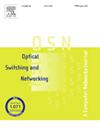量子网络对目标攻击的弹性分析:通过重路由和净化恢复
IF 3.1
4区 计算机科学
Q3 COMPUTER SCIENCE, INFORMATION SYSTEMS
引用次数: 0
摘要
量子网络对于安全量子通信和分布式量子计算至关重要。然而,它们的性能非常容易受到破坏纠缠分布的目标攻击,从而导致严重的网络退化。为了解决这一挑战,我们提出了两种启发路由算法量子纠缠分布算法1 (QEDA1)和量子纠缠分布算法2 (QEDA2),它们通过减少中间节点的数量来最小化保真度损失,同时优化纠缠交换和净化策略。在QEDA1中,我们只将纯化作为一种恢复机制,而在QEDA2中,我们使用了纯化-重路由方法。此外,与之前主要依赖于理想化或小规模拓扑的研究不同,我们在现实世界的网络拓扑(Surfnet)上评估了我们的方法,分析了正常条件下和目标攻击下的吞吐量变化。此外,我们比较了该算法在记忆辅助和无记忆量子网络中的性能,展示了量子记忆对网络弹性的影响。此外,我们引入了一种基于中心性驱动节点故障的攻击模型,并提出了一种集成了重路由和纠缠净化的恢复机制,以减轻目标攻击的影响。我们的结果表明,QEDA2在减轻攻击对吞吐量的影响方面更有效。此外,我们的研究结果强调了网络鲁棒性、资源分配和保真度约束之间的权衡,为弹性大规模量子网络的设计提供了有价值的见解。本文章由计算机程序翻译,如有差异,请以英文原文为准。
Resilience analysis of quantum network against targeted attacks: Recovery via rerouting and purification
Quantum networks are essential for secure quantum communication and distributed quantum computing. However, their performance is highly vulnerable to targeted attacks that disrupt entanglement distribution, leading to significant network degradation. To address this challenge, we propose two heuristic routing algorithms Quantum Entanglement Distribution Algorithm 1 (QEDA1) and Quantum Entanglement Distribution Algorithm 2 (QEDA2) that minimize loss of fidelity by reducing the number of intermediate nodes while optimizing entanglement swapping and purification strategies. In QEDA1 we only applied purification as a recovery mechanism, while in QEDA2 we utilized a purification-rerouting approach. Furthermore, unlike previous studies, which relied primarily on idealized or small-scale topologies, we evaluated our approach on a real-world network topology (Surfnet), analyzing throughput variations under both normal conditions and targeted attacks. Furthermore, we compare the performance of the algorithm in memory-assisted and memoryless quantum networks, demonstrating the impact of quantum memory on network resilience. In addition, we introduce an attack model based on centrality-driven node failures and propose a recovery mechanism that integrates rerouting and entanglement purification to mitigate the effects of targeted attacks. Our results indicate that QEDA2 is more effective in mitigating the effect of attacks on throughput. Moreover, our findings highlight the trade-offs between network robustness, resource allocation, and fidelity constraints, providing valuable insights for the design of resilient large-scale quantum networks.
求助全文
通过发布文献求助,成功后即可免费获取论文全文。
去求助
来源期刊

Optical Switching and Networking
COMPUTER SCIENCE, INFORMATION SYSTEMS-OPTICS
CiteScore
5.20
自引率
18.20%
发文量
29
审稿时长
77 days
期刊介绍:
Optical Switching and Networking (OSN) is an archival journal aiming to provide complete coverage of all topics of interest to those involved in the optical and high-speed opto-electronic networking areas. The editorial board is committed to providing detailed, constructive feedback to submitted papers, as well as a fast turn-around time.
Optical Switching and Networking considers high-quality, original, and unpublished contributions addressing all aspects of optical and opto-electronic networks. Specific areas of interest include, but are not limited to:
• Optical and Opto-Electronic Backbone, Metropolitan and Local Area Networks
• Optical Data Center Networks
• Elastic optical networks
• Green Optical Networks
• Software Defined Optical Networks
• Novel Multi-layer Architectures and Protocols (Ethernet, Internet, Physical Layer)
• Optical Networks for Interet of Things (IOT)
• Home Networks, In-Vehicle Networks, and Other Short-Reach Networks
• Optical Access Networks
• Optical Data Center Interconnection Systems
• Optical OFDM and coherent optical network systems
• Free Space Optics (FSO) networks
• Hybrid Fiber - Wireless Networks
• Optical Satellite Networks
• Visible Light Communication Networks
• Optical Storage Networks
• Optical Network Security
• Optical Network Resiliance and Reliability
• Control Plane Issues and Signaling Protocols
• Optical Quality of Service (OQoS) and Impairment Monitoring
• Optical Layer Anycast, Broadcast and Multicast
• Optical Network Applications, Testbeds and Experimental Networks
• Optical Network for Science and High Performance Computing Networks
 求助内容:
求助内容: 应助结果提醒方式:
应助结果提醒方式:


